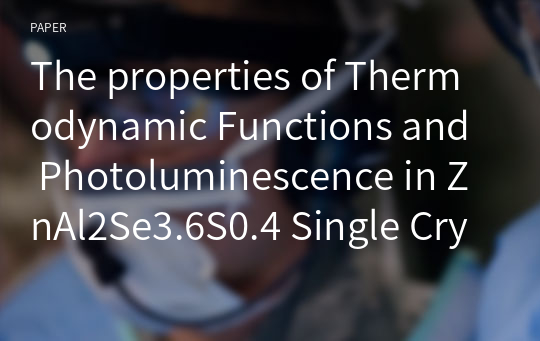The properties of Thermodynamic Functions and Photoluminescence in ZnAl2Se3.6S0.4 Single Crystal
* 본 문서는 배포용으로 복사 및 편집이 불가합니다.
서지정보
ㆍ발행기관 : 대한시과학회
ㆍ수록지정보 : 대한시과학회지 / 18권 / 4호
ㆍ저자명 : Kwang-Ho Park, Seung-Cheol Hyun, Duck-Tae Kim
ㆍ저자명 : Kwang-Ho Park, Seung-Cheol Hyun, Duck-Tae Kim
목차
Ⅰ. 서 론Ⅱ. 실 험
Ⅲ. 실험결과 및 고찰
Ⅳ. 결 과
References
한국어 초록
목 적: Ⅱ-Ⅲ2-Ⅵ4형 반도체 가운데 고용체 화합물에 대한 연구의 하나로 Ⅵ족인 S, Se를 상호 교환하여 성장시킨 ZnAl2Se3.6S0.4 고용체의 구조 및 광 발광 메카니즘을 규명하였고, 이로부터 광학적 energy band gap의 온도의존성과 기초적 열역학 함수를 추정고자 한다.방 법: ZnAl2Se3.6S0.4 단결정은 수송매체로서 iodine을 이용한 화학수송법(CTR)으로 단결정을 성장시켰 다. 단결정을 성장시키기 위하여 시료 출발측을 950 ℃, 성장측을 850 ℃로 하여 7일간 성장시켰다. 기초 흡 수단 부근에서 에너지 띠 간격의 온도의존성을 구하기 위하여 저온장치가 부착된 UV-VIS-NIR spectrophotometer를 사용하여 광흡수 스펙트럼을 측정하였다. 광발광 특성은 광흡수 특성 측정에 사용하 였던 측정용 시편을 cryogenic system 의 cold finger 에 부착시키고, 여기 광원으로 325 ㎚의 He-Cd laser 를 사용하였으며, double-grating monochromator, data-mate control system, cryogenic system, PM tube 등으로 구성된 측정 system을 사용하여 측정하였다.
결과 및 고찰: ZnAl2Se3.6S0.4 단결정의 에너지 띠 간격과 온도의존성을 구하기 위하여 이들 단결정의 기 초 흡수단 영역인 320 ~ 420㎚ 파장영역과 13K ~ 289K 온도영역에서 광흡수 스펙트럼을 측정하였다. Varshni가 제안한 에너지 띠 간격의 온도의존성 특성에 대한 실험식에 잘 일치하였다. 측정된 energy gap(Eg)으로부터 열역학적 함수 물리량을 추정할 수 있었다. 또한 13K에서 측정한 광발광 스펙트럼에서 보 면 427㎚(2.904 )영역에서 비교적 넓고 세기가 강한 청색 발광 피크와 468㎚(2.648 )영역에서 세기가 약한 청색 발광 피크를 관측할 수 있었다. 결 론: ZnAl2Se3.6S0.4 단결정의 결정구조는 defect chacopyrite 구조였으며, 격자 상수는 a= 5.5563Å, c= 10.8324Å이었다. 또한 찌그러짐 인자값은 0.0504 이었다. 광학적 에너지 띠 간격의 온도 의존성을 규명하 였고, 이 때 Eg(0)=3.538(eV), α=2.02×10-3(eV/K), β=502.19(K)로 주어졌다. Energy band gap의 온도의 존성으로부터 entropy(SCV), heat capacity(CCV), enthalpy(HCV) 값을 추정 할 수 있었다. ZnAl2Se3.6S0.4 결 정의 광발광 특성은 비교적 넓고 세기가 강한 청색 발광 피크와 세기가 약한 청색 발광 피크를 관측할 수 있었 다. 이들 발광 전이기구는 두개의 주개 준위(SD1, DD1)와 한 개의 받개 준위(DA1)사이의 재결합에 의한 발광 메카니즘으로 설명된다.
영어 초록
Purpose: As a study on solid solution compound of the Ⅱ-Ⅲ2-Ⅵ4 type semiconductor, we investigated the structure and photoluminescence properties of ZnAl2Se3.6S0.4 solid solution and from these properties we calculated the temperature dependence of optical band gap and estimated fundamental thermodynamic functions.Methods: ZnAl2Se3.6S0.4 single crystal was grown by CTR method using iodine as a transporting material. We positioned the ampoule in the middle of the two zones furnace, we maintained 7 days at 950 ℃ in the starting site and 850 ℃ in the growing site, respectively. To obtain the temperature dependence of the optical energy band gap at fundamental absorption edge, optical absortion spectrum was measured by UV-VIS-NIR spectrophotometer equipped with cryogenic system. Photoluminescence property of the sample located at the finger of cryogenic system was examined by the measurement system equipped with 325㎚ He-Ne laser, double-grating monochromator, data-mate control system, cryogenic system and PM tube.
Results and Consideration: To obtain the temperature dependences of the energy band gaps, we examined the optical absorption spectra in the wavelength range 320 – 420㎚ around the fundamental absorption edge and in the temperature range 13 – 289K. The temperature dependences of the energy band gaps was well fitted with Varshni equation. We could deduct the thermodynamic functions from the temperature dependent optical energy band gap(Eg). Also, in the photoluminescence spectrum measured at 13K, we could observe a wide-strong peak at 427㎚(2.904eV) and weak blue one at 468㎚ (2.648eV), respectively.
Conclusions: The ZnAl2Se3.6S0.4 single crystal had defect chalcopyrite structure and the lattice constants were a= 5.5563Å, c= 10.8324Å, respectively. The distortion factor of this lattice constants was 0.0504. From the temperature dependences of the energy band gaps, we obtained Eg(0)=3.538(eV), α=2.02×10-3(eV/K), β=502.19(K), respectively. Also, we could deduct the thermodynamic functions from the measured-temperature dependent optical energy band gap(Eg). And, at 13K, we could observe a wide-strong blue photoluminescence peak at 427㎚(2.904eV) and weak blue one at 468㎚ (2.648eV), respectively. These two photoluminescence peaks was explained by the recombination mechanism between two donor levels(SD1, DD1) and one acceptor level(DA1).
참고 자료
없음태그
"대한시과학회지"의 다른 논문
 Comparison of Accuracy of the KR-8100P, Nvision K-5001,..11페이지
Comparison of Accuracy of the KR-8100P, Nvision K-5001,..11페이지 Accuracy of Axial Length Calculation Using Schematic Ey..9페이지
Accuracy of Axial Length Calculation Using Schematic Ey..9페이지 Study on the Perception and the Actual State of Volunta..12페이지
Study on the Perception and the Actual State of Volunta..12페이지 Effect of Orthokeratology on Visual Correction in Myopi..12페이지
Effect of Orthokeratology on Visual Correction in Myopi..12페이지 A Study on Optician's Job Satisfaction and Price Reliab..8페이지
A Study on Optician's Job Satisfaction and Price Reliab..8페이지 The Effects of Pinhole on Decimal Visual Acuity, Spheri..9페이지
The Effects of Pinhole on Decimal Visual Acuity, Spheri..9페이지 The degree of myopia in same age group by visit year in..8페이지
The degree of myopia in same age group by visit year in..8페이지 The Characteristic of the Change for Ophthalmic Lens Co..9페이지
The Characteristic of the Change for Ophthalmic Lens Co..9페이지 Study on the blue light hazard protection rate of blue ..9페이지
Study on the blue light hazard protection rate of blue ..9페이지 Study on the Feasibility to Establish Institution of Ce..11페이지
Study on the Feasibility to Establish Institution of Ce..11페이지


























